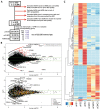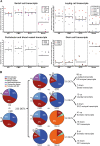Transcriptome analysis of the adult human Klinefelter testis and cellularity-matched controls reveals disturbed differentiation of Sertoli- and Leydig cells
- PMID: 29789566
- PMCID: PMC5964117
- DOI: 10.1038/s41419-018-0671-1
Transcriptome analysis of the adult human Klinefelter testis and cellularity-matched controls reveals disturbed differentiation of Sertoli- and Leydig cells
Abstract
The most common human sex chromosomal disorder is Klinefelter syndrome (KS; 47,XXY). Adult patients with KS display a diverse phenotype but are nearly always infertile, due to testicular degeneration at puberty. To identify mechanisms causing the selective destruction of the seminiferous epithelium, we performed RNA-sequencing of 24 fixed paraffin-embedded testicular tissue samples. Analysis of informative transcriptomes revealed 235 differentially expressed transcripts (DETs) in the adult KS testis showing enrichment of long non-coding RNAs, but surprisingly not of X-chromosomal transcripts. Comparison to 46,XY samples with complete spermatogenesis and Sertoli cell-only-syndrome allowed prediction of the cellular origin of 71 of the DETs. DACH2 and FAM9A were validated by immunohistochemistry and found to mark apparently undifferentiated somatic cell populations in the KS testes. Moreover, transcriptomes from fetal, pre-pubertal, and adult KS testes showed a limited overlap, indicating that different mechanisms are likely to operate at each developmental stage. Based on our data, we propose that testicular degeneration in men with KS is a consequence of germ cells loss initiated during early development in combination with disturbed maturation of Sertoli- and Leydig cells.
Conflict of interest statement
The authors declare that they have no conflict of interest.
Figures







References
-
- Chang S, Skakkebaek A, Gravholt CH. Klinefelter syndrome and medical treatment: hypogonadism and beyond. Horm. (Athens). 2015;14:531–548. - PubMed
Publication types
MeSH terms
Substances
LinkOut - more resources
Full Text Sources
Other Literature Sources
Medical
Molecular Biology Databases

